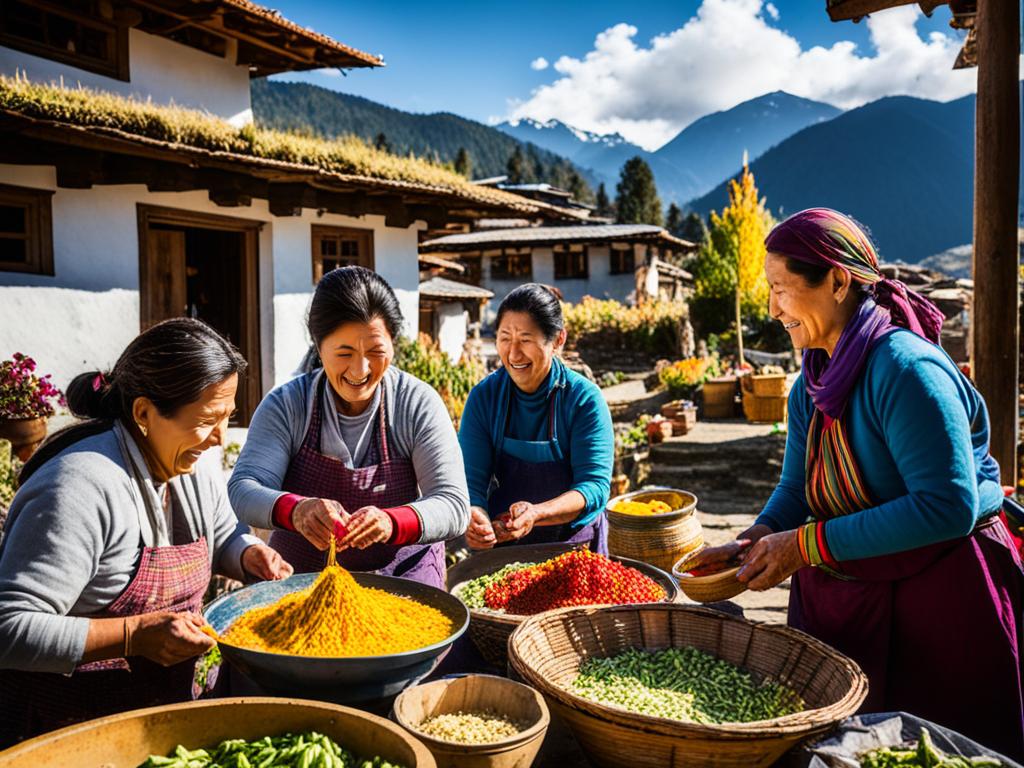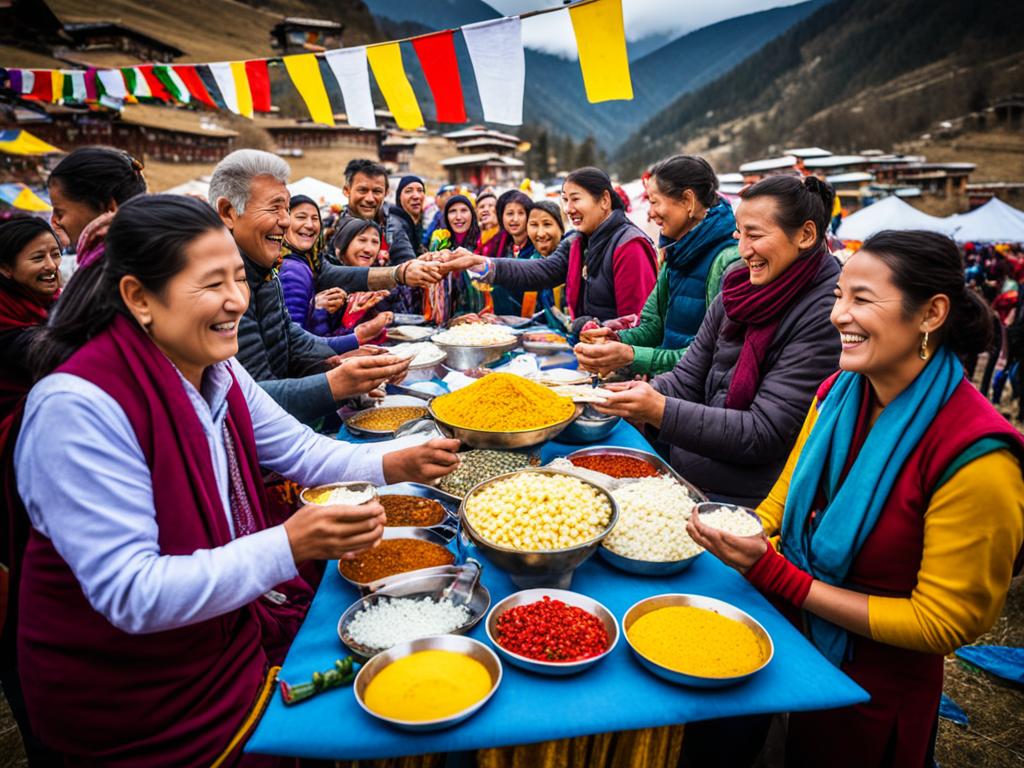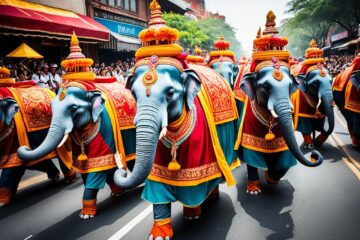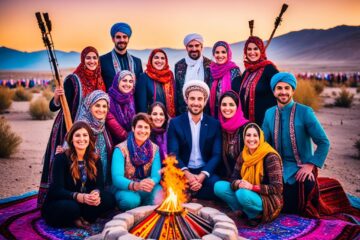Picture yourself in a land of high mountains covered in snow. You’re in Bhutan, a place known for its peaceful vibe and bright, happy atmosphere. It’s Losar, the time when Bhutanese and Tibetan people celebrate New Year.
This celebration is more than just turning the calendar. It’s a way for the people of Bhutan to come together and show love for their culture and Buddhist roots. It’s a blend of deep spiritual moments and fun get-togethers, welcoming a new year.
Losar’s ways are tied to Tibetan Buddhism, making every moment feel sacred and special. For 15 days, there are prayers and special family ceremonies. It’s a time to reflect, but also to celebrate with dances and other joyful events that are important in the Bhutanese way of life.
This special festival happens in February or March. Remember, Tibet isn’t open to outsiders during this time. But, this article opens the door for you to explore the meaning and feel of Losar. You can dive into the beauty and excitement of this rich cultural event from afar.
Key Takeaways:
- Losar is a vibrant cultural celebration in Bhutan, the Himalayan kingdom.
- It is the most important traditional festival, marking the Tibetan New Year.
- Losar lasts for fifteen days and is filled with deep religious observance.
- The customs and activities are closely related to Tibetan Buddhism.
- Travelers can learn about Losar through this article, despite Tibet being closed to foreigners during the festival.
The Origins and Meaning of Losar
Losar is the Tibetan New Year. It is rich in ancient traditions and religious beliefs. Before Buddhism, the Bon kind of religion was followed. People celebrated winter seeking protection from deities.
When Tibetan Buddhism arrived, this winter celebration changed. It included religious practices. This change happened during the Sakya Dynasty’s time in the 13th century. Now, Losar is the start of the Tibetan calendar, symbolizing a new beginning.
Losar is very important to Tibetans. It blends a religious festival with a traditional holiday. During Losar, families and communities come together. They honor their past, show thanks, and ask for blessings for the coming year.
Losar’s celebration mixes history and religious aspects with joy. It blends spiritual devotion and culture. This festival shows the beauty of Tibetan Buddhism and culture. It’s a vibrant display of Tibetan heritage.
The Historical Origins of Losar
Losar has grown from ancient traditions into a key Tibetan festival. The mix of the winter celebration with religion in the Sakya Dynasty made it big. Now, it’s celebrated with much history and culture.
The Religious Significance of Losar
Losar is about renewal and spiritual devotion for Tibetans. It’s a time to seek blessings and clear out bad things. This helps people and communities start the new year with positivity and new beginnings.
The Communal Festivities of Losar
Losar unites people, creating a strong sense of community. It’s a time for families to get together. Communities celebrate with cultural events. Joy is in the air with music, dance, and colorful clothes.
The Cultural Importance of Losar
Losar is vital for Tibetans to keep and show their culture. Through rituals, customs, and performances, they keep their traditions alive. This makes sure the rich heritage is passed on to the next generations.
Customs and Festivities of Losar
Losar is a joyful celebration for Tibetans. It’s a time to come together with family. They enjoy customs like singing and dancing, showing off their talents.
Leading up to the new year, Tibetans perform a unique practice. They wear traditional clothes and chant scriptures. By passing fire torches, they believe they can scare away evil spirits for a lucky year.
The festival also features fun, like the antimasque with its comical deer dance. People laugh a lot during Losar, enjoying playful acts and music. This happy vibe lasts throughout the event.
Losar lets Tibetans share and celebrate their culture. They wear unique, bright clothing that tells stories of their land. This includes a dress called chuba for women and a robe named gho for men.
Key events during Losar are Tibetan opera, dances with masks, and folk music. These shows highlight the community’s skills and love for the arts. The performances are captivating, with rhythmic drums and beautiful dances.
Significance of Family Reunions
Losar is all about family. It’s believed that spending time together during the festival brings luck. Families come together to eat, share gifts, and enjoy each other’s company.
The festival is a time for sharing old stories and traditions. Elders teach the young, helping to keep customs alive from one generation to the next.
Symbolic Rituals and Evil Dislodging
Losar is deeply spiritual. People perform rituals to start afresh and keep negativity away. The tradition of scaring off evil is very important during the festival.
Tibetans light incense and perform the Cham dance to cast out bad spirits. By doing this, they hope for a good year ahead.
“During Losar, we believe that by dressing up in our traditional costumes, chanting Buddhist scriptures, and passing fire torches, we can rid ourselves of evil spirits and make way for a joyful and prosperous new year.”
Antimasque: Laughter and Entertainment
The antimasque, especially the Chamsem Dance, is a big part of Losar. It’s full of jokes and light-hearted performances. The deer dance is a favorite, where dancers pretend to be deer.
Another fun performance is the pretend fight between a king and his helpers. This adds fun and laughter to the celebrations.
Preparation and Celebration of Losar
Losar involves many detailed preparations and customs. These activities are done to mark a good start to the Tibetan New Year. Let’s look at the steps and happy events that define this alive holiday.
Losar Preparations
The lead-up to Losar starts in mid-December. Families are excited for this important festival. One key step is preparing offerings like tsampa, fried wheat grains, and ghee. These offerings are to honor ancestors and ask for their blessings for the year ahead.
Cleaning the home is also crucial for Losar. In Bhutan, families put a lot of effort into cleaning, especially the kitchen. This cleaning practice is to banish negative effects. It helps create a welcoming and pure space for the festival.
New Year’s Eve and Exorcism Rituals
On Losar’s eve, families enjoy a special meal called Gutu. They eat Dough Balls with special fillings that represent their wishes for the coming year. This meal is a happy time that brings families closer together.
“New Year’s Eve during Losar is a time for relatives to gather around the family hearth, when the eldest male member of the family lights a torch and recites sacred chants to dispel any harmful elements and usher in positive energies for the year to come.”
Water Grab and Communal Festivities
Losar’s first day has a unique event called the water grab. The housewife from each family fetches the first water of the New Year. This custom represents good luck and plenty.
During Losar, people share greetings and good wishes. This helps build a strong community spirit. Everyone prays for peace and health, showing their united faith. The festival lasts for three days. It includes visiting friends and showing traditional customs like dances and music.
Losar marks a special time in Bhutan, blending faith, culture, and community. The detailed preparations and rituals lead to an enjoyable celebration. This festival is a key part of the local culture.

Conclusion
Bhutan – Losar is a vibrant celebration of the Tibetan New Year in the Himalayan kingdom. It shows off Bhutan’s rich culture and deep religious beliefs. This festival is filled with family, music, and dancing.
People join together to get rid of evil and wish for a good year ahead. Losar is a special time to see Bhutan’s lively culture and how much they value community.




